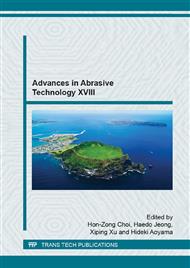p.104
p.113
p.119
p.125
p.131
p.137
p.143
p.149
p.156
Study on Effect of Viscoelastic Properties on Surface Roughness Uniformity in Abrasive Flow Machining for Plate Surface
Abstract:
Abrasive flow machining is a suitable technique for surface polishing due to its rheological characteristics, however, it's difficult to achieve uniform roughness for polished surfaces as the material removal mechanism is still ambiguous. In this paper the viscoelastic properties of abrasive flow media are incorporated to explore the phenomena of inconsistent material removal in the AFM polishing process, where the material removal near the edges is obviously higher than that in the middle along the flow direction. The rheological parameters of the viscoelastic constitutive model adopted are varied to study the polishing effectiveness under different process conditions. The results of numerical analysis reveal that there exist distinct differences of viscoelastic stress fields between the edges and the middle regions, which leads to the material removal near the edges is higher than that in the middle. It could be concluded that the viscoelastic properties of abrasive media play the dominant role for the inconsistent material removal in abrasive flow machining process.
Info:
Periodical:
Pages:
131-134
Citation:
Online since:
January 2016
Authors:
Price:
Сopyright:
© 2016 Trans Tech Publications Ltd. All Rights Reserved
Share:
Citation:


